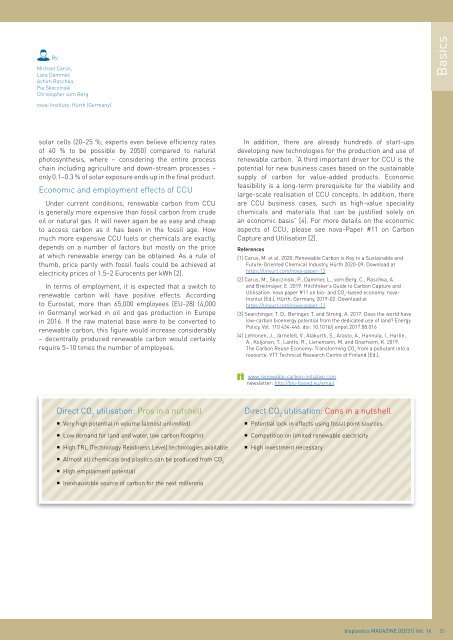issue 03/2021
Highlights: Bottles / Blow Moulding Joining Bioplastics Basics: Carbon Capture
Highlights:
Bottles / Blow Moulding
Joining Bioplastics
Basics: Carbon Capture
- No tags were found...
You also want an ePaper? Increase the reach of your titles
YUMPU automatically turns print PDFs into web optimized ePapers that Google loves.
By:<br />
Michael Carus,<br />
Lara Dammer,<br />
Achim Raschka,<br />
Pia Skoczinski<br />
Christopher vom Berg<br />
Basics<br />
nova-Institute, Hürth (Germany)<br />
solar cells (20–25 %; experts even believe efficiency rates<br />
of 40 % to be possible by 2050) compared to natural<br />
photosynthesis, where – considering the entire process<br />
chain including agriculture and down-stream processes –<br />
only 0.1–0.3 % of solar exposure ends up in the final product.<br />
Economic and employment effects of CCU<br />
Under current conditions, renewable carbon from CCU<br />
is generally more expensive than fossil carbon from crude<br />
oil or natural gas. It will never again be as easy and cheap<br />
to access carbon as it has been in the fossil age. How<br />
much more expensive CCU fuels or chemicals are exactly,<br />
depends on a number of factors but mostly on the price<br />
at which renewable energy can be obtained. As a rule of<br />
thumb, price parity with fossil fuels could be achieved at<br />
electricity prices of 1.5–2 Eurocents per kWh [2].<br />
In terms of employment, it is expected that a switch to<br />
renewable carbon will have positive effects. According<br />
to Eurostat, more than 65,000 employees (EU-28) (4,000<br />
in Germany) worked in oil and gas production in Europe<br />
in 2016. If the raw material base were to be converted to<br />
renewable carbon, this figure would increase considerably<br />
– decentrally produced renewable carbon would certainly<br />
require 5–10 times the number of employees.<br />
In addition, there are already hundreds of start-ups<br />
developing new technologies for the production and use of<br />
renewable carbon. “A third important driver for CCU is the<br />
potential for new business cases based on the sustainable<br />
supply of carbon for value-added products. Economic<br />
feasibility is a long-term prerequisite for the viability and<br />
large-scale realisation of CCU concepts. In addition, there<br />
are CCU business cases, such as high-value speciality<br />
chemicals and materials that can be justified solely on<br />
an economic basis” [4]. For more details on the economic<br />
aspects of CCU, please see nova-Paper #11 on Carbon<br />
Capture and Utilisation [2].<br />
References<br />
[1] Carus, M. et al. 2020: Renewable Carbon is Key to a Sustainable and<br />
Future-Oriented Chemical Industry, Hürth 2020-09; Download at<br />
https://tinyurl.com/nova-paper-12<br />
[2] Carus, M., Skoczinski, P., Dammer, L., vom Berg, C., Raschka, A.<br />
and Breitmayer, E. 2019. Hitchhiker’s Guide to Carbon Capture and<br />
Utilisation. nova paper #11 on bio- and CO 2<br />
-based economy. nova-<br />
Institut (Ed.), Hürth, Germany, 2019-02. Download at<br />
https://tinyurl.com/nova-paper-11<br />
[3] Searchinger, T. D., Beringer, T. and Strong, A. 2017. Does the world have<br />
low-carbon bioenergy potential from the dedicated use of land? Energy<br />
Policy, Vol. 110 434-446. doi: 10.1016/j.enpol.2017.08.016<br />
[4] Lehtonen, J., Järnefelt, V., Alakurtti, S., Arasto, A., Hannula, I., Harlin,<br />
A., Koljonen, T., Lantto, R., Lienemann, M. and Onarheim, K. 2019.<br />
The Carbon Reuse Economy: Transforming CO 2<br />
from a pollutant into a<br />
resource. VTT Technical Research Centre of Finland (Ed.),<br />
www.renewable-carbon-initiative.com<br />
newsletter: http://bio-based.eu/email<br />
Direct CO 2<br />
utilisation: Pros in a nutshell<br />
• Very high potential in volume (almost unlimited)<br />
• Low demand for land and water, low carbon footprint<br />
• High TRL (Technology Readiness Level) technologies available<br />
Direct CO 2<br />
utilisation: Cons in a nutshell<br />
• Potential lock in effects using fossil point sources<br />
• Competition on limited renewable electricity<br />
• High investment necessary<br />
• Almost all chemicals and plastics can be produced from CO 2<br />
• High employment potential<br />
• Inexhaustible source of carbon for the next millennia<br />
bioplastics MAGAZINE [<strong>03</strong>/21] Vol. 16 55


















